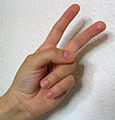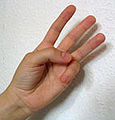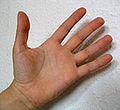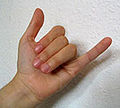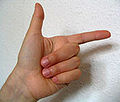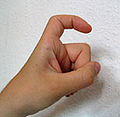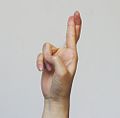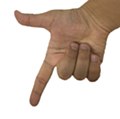Chinese numerals
The traditional system of the Chinese numerals ( Chinese 數字 / 数字 , Pinyin shùzì , Zhuyin ㄕ ㄨ ˋ ㄗ ˋ - "digit, number") is used in Chinese everyday life in addition to the Arabic numerals . These characters are also used in other countries with Chinese script (especially Japan , very rarely in Korea and Vietnam ).
The representation is a mixture between addition and place value system on the basis of decimal digits . A number is represented as the sum of terms of the form d × 10 n , with the digits 0 to 9 and the power of ten each represented by their own characters. The numbers composed of the characters are identical to written numerals in the spoken language.
Character list
The Chinese numbers from 0 to 10:
The following characters are common:
| Character a | Form in finance b | Pinyin | Zhuyin | Numerical value |
|---|---|---|---|---|
| 零 / 〇 c | 零 | líng | ㄌ ㄧ ㄥ ˊ | 0 |
| 一 | 壹 ﹐ 弌 | yī, yāo d | ㄧ | 1 |
| 二 / 兩 ( abbreviation 两 ) e | 貳 ﹐ 弍 | èr / liǎng | ㄦ ˋ / ㄌ ㄧ ㄤ | 2 |
| 三 | 叄 ( abbreviation 叁 ) ,弎 | sān | ㄙ ㄢ | 3 |
| 四 | 肆 | sì | ㄙ ˋ | 4th |
| 五 | 伍 | wǔ | ㄨ ˇ | 5 |
| 六 | 陸 ( abbreviation 陆 ) | liù | ㄌ ㄧ ㄡ ˋ | 6th |
| 七 | 柒 | qī | ㄑ ㄧ | 7th |
| 八 | 捌 | bā | ㄅ ㄚ | 8th |
| 九 | 玖 | jiǔ | ㄐ ㄧ ㄡ ˇ | 9 |
| 十 | 拾 | shí | ㄕ ˊ | 10 |
| 百 | 佰 | bǎi | ㄅ ㄞ ˇ | 100 |
| 千 | 仟 | qiān | ㄑ ㄧ ㄢ | 1000 |
| 萬 ( abbreviation 万 ) | 萬 | wàn | ㄨ ㄢ ˋ | 10 4 = 10,000 |
| 億 ( abbreviation 亿 ) | 億 | yì | ㄧ ˋ | 10 8 (100 million) |
| 兆f | 兆 | zhào | ㄓ ㄠ ˋ | 10 12 (1 trillion) |
| 京 | jīng | ㄐ ㄧ ㄥ | 10 16 (10 quadrillion) |
|
| 垓 | gāi | ㄍ ㄞ | 10 20 (100 trillion ) |
|
| 秭 | zǐ | ㄗ ˇ | 10 24 (1 quadrillion ) |
|
| 穰 | rank | ㄖ ㄤ ˊ | 10 28 (10 quadrillion ) |
|
| 溝 ( abbreviation 沟 ) | gou | ㄍ ㄡ | 10 32 (100 quintillion) |
|
| 澗 ( abbreviation 涧 ) | jiàn | ㄐ ㄧ ㄢ ˋ | 10 36 (1 sextillion) |
|
| 正 | zhèng | ㄓ ㄥ ˋ | 10 40 (10 sextillion) |
|
| 載 ( abbreviation 载 ) | zài | ㄗ ㄞ ˋ | 10 44 (100 septillion) |
Beyond 10,000, the Chinese Wikipedia page corresponding to this page counts in steps of 10,000 as in the list above, but indicates that other numerical values were previously assigned to the respective characters. That is still partly the case today. For example, the character 京 in The new Chinese-German dictionary and in the electronic dictionary Pleco has a numerical value of 10 million instead of 10 quadrillion as above.
In the People's Republic of China, 兆 ( 萬億 , wànyì = 10,000 × 100 million) is used instead of 兆 for trillion .
For the notation of 廿 , 卅 and 卌 (niàn, sà and xì) for 20, 30 and 40 see below "Formation of the numbers".
In military communication and aviation , the following numbers are read differently for the sake of clarity:
| number | Standard reading | Military and aviation |
|---|---|---|
| 0 | 〇 / 零 (líng) | 洞 (dòng) |
| 1 | 一 (yī) | 幺 / 么 (yāo) |
| 2 | 二 (èr) | 两 / 兩 (liǎng) |
| 7th | 七 (qī) | 拐 (guǎi) |
| 9 | 九 (jiǔ) | 勾 (gōu) |
Forming the numbers
In the Chinese number system , larger composite numbers are formed both multiplicatively (tens, hundreds, thousands, and so on) and additively. The point serves as the decimal separator .
Examples:
- The tens, hundreds, thousands, tens of thousands and hundreds of millions are multiplied:
- 20: 二十 (2 × 10); 30: 三十 (3 × 10); 40: 四十 (4 × 10); 200: 二百 or 兩百 (2 × 100); 4000: 四千 (4 × 1000); 60 000: 六萬 (6 × 10 000) and so on.
- For numbers between 10 and 19, it is not necessary to specify the quantity for the tens:
- 11 ﹕ 十一 (10 + 1) ﹔ 12 ﹕ 十二 (10 + 2); 19: 十九 (10 + 9) and so on.
- The intermediate stages are formed additively. So z. B. the number 97 375 formed as follows:
- 9 × 10 000 + 7 × 1000 + 3 × 100 + 7 × 10 + 5, or in characters: 九萬 七千 三百 七 十五 (Pinyin: jiǔwàn qīqiān sānbǎi qīshíwǔ ).
- 111 = 1 × 100 + 1 × 10 + 1: 一百 一 十一 ;
- It is possible - albeit rarely - to leave out the last character with a value greater than 9 if it was preceded by a character with a higher value, e.g. B. the number 350 can be shortened by the expression in brackets:
- 3 × 100 + 5 (× 10); in characters:
- 三百 五十 or 三百 五 for short .
- A zero must therefore be inserted for missing places (trailing zeros are not mentioned), e.g. B. for the number 8 734 072:
- (8 × 100 + 7 × 10 + 3) × 10,000 + 4 × 1,000 + 0 + 7 × 10 + 2
- or in characters:
- 八百 七十 三萬 四千 〇 七 十二 .
- If two or more digits are missing, only a zero is inserted, e.g. B. the number 10 020:
- 1 × 10,000 + 0 + 2 × 10
- in characters:
- 一 萬 〇 二十 .
- The symbol 廿 is also often written for 20 . It is actually pronounced niàn , but mostly regularly èrshí . 廿 has a rarer orthographic variant ere .
- For 30 you also see the sign 卅 more often . It is actually spoken sà , but mostly regular sānshí .
- The character 卌 is sometimes written for 40 . It is actually spoken xì , but mostly sìshí in the regular manner .
- The character 皕 is very rarely written for 200 . It is actually spoken bì , but mostly regular èrbǎi or liǎngbǎi .
counting
In the Chinese language , counting is done using counting words . There are separate counting words for different groups of nouns ; a general counting word is 個 / 个 gè . So 五 個人 / 五 个人 wǔgèrén denotes five people .
By prefixing the character 第 dì be ordinals formed. So 第五 個人 / 第五 个人 dìwǔgèrén denotes a fifth person .
See also: Count Word (Chinese) for an explanation of the Chinese count words.
Hand sign expressing Chinese numbers
In China, numbers can be indicated by gesturing with one hand. The following pictures show the numbers from one to ten:
From 1 to 5
2 - forefinger and middle finger are stretched and form a V (as with the victory sign )
From 6 to 10: North China
6 - the little finger and the thumb are spread, the other fingers closed ( iconic for 六 , liù - "six")
9 - all fingers are closed, except for the index finger, which shows a hook when the base joint is open
From 6 to 10: South China
Note: The above hand signs for seven, eight, and nine are very different from those used in Taiwan and Hong Kong . The seven is shown with the thumb and forefinger, the eight with the thumb, forefinger and middle finger, and the nine with the thumb and three other fingers. In Singapore z. B. used the symbol shown here for 7 as 5. In Hong Kong, the clenched fist is also considered a “5”.
See also
literature
- Li Dejin, Cheng Meizhen: Practical Chinese grammar for foreigners. CBT China Book Trading GmbH 2009, ISBN 978-3-941284-03-6 .
- Georges Ifrah: Universal History of Numbers. 2nd Edition. Campus-Verlag, Frankfurt am Main u. a. 1991, ISBN 3-88059-956-4 .
Individual evidence
- ↑ 現代 漢語 詞典 修訂 版 中國科學院 語言 研究所 詞典 編輯 室 編 商務印書館 Xiandai Hanyu Cidian (Modern Chinese Dictionary Revised Edition, Dictionary Editor , Institute of Linguistics, Chinese Academy of Sciences) 3rd edition 1988 ISBN 962-07-0070- 8th
- ↑ 飛行 管理 程序 (ATMP) CHG-6 中華民國 一 O 一年 十一月 三十 日 - 民用航空局 - 空軍 司令部 (Office of Civil Aviation - Command Staff of the Taiwan Air Force, Republic of China) 2012, p. 89 PDF



